Alpha Particle Effect on Multi-Nanosheet Tunneling Field-Effect Transistor at 3-nm Technology Node
Abstract
:1. Introduction
2. Three-Dimensional (3D) Device and Methodology
3. Results and Discussion
4. Conclusions
Author Contributions
Funding
Acknowledgments
Conflicts of Interest
References
- Huang, X.; Zeng, Z.Y.; Zhang, H. Metal dichalcogenide nanosheets: Preparation, properties and applications. Chem. Soc. Rev. 2013, 42, 1934–1946. [Google Scholar] [CrossRef] [PubMed]
- Seo, Y.; Kim, S.; Ko, K.; Woo, C.; Kim, M.; Lee, J.; Kang, M.; Shin, H. Analysis of electrical characteristics and proposal of design guide for ultra-scaled nanoplate vertical FET and 6T-SRAM. Solid State Electron. 2018, 140, 69–73. [Google Scholar] [CrossRef]
- Kim, H.; Son, D.; Myeong, I.; Ryu, D.; Park, J.; Kang, M.; Jeon, J.; Shin, H. Strain Engineering for 3.5-nm Node in Stacked-Nanoplate FET. IEEE Trans. Electron Devices 2019, 66, 2898–2903. [Google Scholar] [CrossRef]
- Jeong, J.; Yoon, J.S.; Lee, S.; Baek, R.H. The Effects of Realistic U-shaped Source/Drain on DC/AC Performances of Silicon Nanosheet FETs for Sub 5-nm Node SoC Applications. In Proceedings of the 2019 Electron Devices Technology and Manufacturing Conference (EDTM), Singapore, 12–15 March 2019; pp. 133–135. [Google Scholar]
- Li, H.H.; Lin, Y.R.; Wu, Y.C.; Lin, Y.H.; Yu, J.J. Multi-stacking hybrid P/N/P nanosheet layers junctionless field-effect transistors. In Proceedings of the 2018 7th International Symposium on Next Generation Electronics (ISNE) IEEE, Taipei, Taiwan, 7–9 May 2018; pp. 1–3. [Google Scholar]
- Hossain, N.M.; Quader, S.; Siddik, A.B.; Chowdhury, M.I.B. TCAD based performance analysis of junctionless cylindrical double gate all around FET up to 5nm technology node. In Proceedings of the 2017 20th International Conference of Computer and Information Technology (ICCIT) IEEE, Dhaka, Bangladesh, 22–24 December 2017; pp. 1–4. [Google Scholar]
- Chen, G.; Li, M.; Fan, J.; Yang, Y.; Zhang, H.; Huang, R. Multi-V T design of vertical channel nanowire FET for sub-10nm technology node. In Proceedings of the 2016 IEEE International Nanoelectronics Conference (INEC) IEEE, Chengdu, China, 9–11 May 2016; pp. 1–2. [Google Scholar]
- Tsai, M.J.; Peng, K.H.; Lin, Y.R.; Wu, Y.C. Comparison of Vertically Double Stacked Poly-Si Nanosheet Junctionless Field Effect Transistors with Gate-all-around and Multi-gate Structure. In Proceedings of the 2019 International Symposium on VLSI Technology, Systems and Application (VLSI-TSA) IEEE, Hsinchu, Taiwan, 22–25 April 2019; pp. 1–2. [Google Scholar]
- Choi, W.Y.; Park, B.G.; Lee, J.D.; Liu, T.J.K. Tunneling field-effect transistors (TFETs) with subthreshold swing (SS) less than 60 mV/dec. IEEE Electron Device Lett. 2007, 28, 743–745. [Google Scholar] [CrossRef]
- Zhang, Q.; Zhao, W.; Seabaugh, A. Low-subthreshold-swing tunnel transistors. IEEE Electron Device Lett. 2006, 27, 297–300. [Google Scholar] [CrossRef]
- Krupkina, T.Y.; Artamonova, E.A.; Krasukov, A.Y.; Losev, V.V.; Solovev, A.V. TCAD simulation of TFET structures integrated in basic CMOS technology. In Proceedings of the 2017 IEEE Conference of Russian Young Researchers in Electrical and Electronic Engineering (EIConRus) IEEE, St. Petersburg, Russia, 1–3 February 2017; pp. 471–474. [Google Scholar]
- Chen, F.; Ilatikhameneh, H.; Tan, Y.; Klimeck, G.; Rahman, R. Switching Mechanism and the Scalability of vertical-TFETs. IEEE Trans. Electron Devices 2018, 65, 3065–3068. [Google Scholar] [CrossRef] [Green Version]
- Avci, U.E.; Morris, D.H.; Young, I.A. Tunnel field-effect transistors: Prospects and challenges. IEEE J. Electron Devices Soc. 2015, 3, 88–95. [Google Scholar] [CrossRef]
- Pradhan, K.P.; Sahu, P.K. Heavy-Ion Irradiation effect in trigate SOI tunnel FETs with High-k Spacer technology. In Proceedings of the 2016 IEEE Region 10 Conference (TENCON) IEEE, Singapore, 22–25 November 2016; pp. 2373–2376. [Google Scholar]
- Kim, J.; Lee, J.S.; Han, J.W.; Meyyappan, M. Single-event transient in FinFETs and nanosheet FETs. IEEE Electron Device Lett. 2018, 39, 1840–1843. [Google Scholar] [CrossRef]
- Wang, Q.; Liu, H.; Wang, S.; Chen, S. TCAD simulation of single-event-transient effects in L-shaped channel tunneling field-effect transistors. IEEE Trans. Nucl. Sci. 2018, 65, 2250–2259. [Google Scholar] [CrossRef]
- Black, J.D.; Ball Ii, D.R.; Robinson, W.H.; Fleetwood, D.M.; Schrimpf, R.D.; Reed, R.A.; Black, D.A.; Warren, K.M.; Tipton, A.D.; Dodd, P.E.; et al. Characterizing SRAM single event upset in terms of single and multiple node charge collection. IEEE Trans. Nucl. Sci. 2008, 55, 2943–2947. [Google Scholar] [CrossRef]
- Liu, T.; Liu, J.; Xi, K.; Zhang, Z.; He, D.; Ye, B.; Ying, Y.; Ji, Q.; Wang, B.; Luo, J.; et al. Heavy Ion Radiation Effects on a 130-nm COTS NVSRAM Under Different Measurement Conditions. IEEE Trans. Nucl. Sci. 2018, 65, 1119–1126. [Google Scholar] [CrossRef]
- Edwards, R.; Dyer, C.; Normand, E. Technical standard for atmospheric radiation single event effects (SEE) on avionics electronics. In Proceedings of the 2004 IEEE Radiation Effects Data Workshop (IEEE Cat. No. 04TH8774) IEEE, Atlanta, GA, USA, 22 July 2004; pp. 1–5. [Google Scholar]
- Torres, H.L.F.; Martino, J.A.; Rooyackers, R.; Vandooren, A.; Simoen, E.; Claeys, C.; Agopian, P.G.D. Proton radiation effects on the self-aligned triple gate SOI p-type tunnel FET output characteristic. In Proceedings of the 2017 32nd Symposium on Microelectronics Technology and Devices (SBMicro) IEEE, Fortaleza, Brazil, 28 August–1 September 2017; pp. 1–4. [Google Scholar]
- Cao, J.; Xu, L.; Bhuva, B.L.; Wen, S.J.; Wong, R.; Narasimham, B.; Massengill, L.W. Alpha Particle Soft-Error Rates for D-FF Designs in 16-Nm and 7-Nm Bulk FinFET Technologies. In Proceedings of the 2019 IEEE International Reliability Physics Symposium (IRPS) IEEE, Monterey, CA, USA, 31 March–4 April 2019; pp. 1–5. [Google Scholar]
- Munteanu, D.; Autran, J.L. Modeling and simulation of single-event effects in digital devices and ICs. IEEE Trans. Nucl. Sci. 2008, 55, 1854–1878. [Google Scholar] [CrossRef]
- Uemura, T.; Lee, S.; Min, D.; Moon, I.; Lim, J.; Lee, S.; Sagong, H.C.; Pae, S. Investigation of alpha-induced single event transient (SET) in 10 nm FinFET logic circuit. In Proceedings of the 2018 IEEE International Reliability Physics Symposium (IRPS), IEEE, Burlingame, CA, USA, 11–15 March 2018; p. P-SE. [Google Scholar]
- Atkinson, N.M.; Ahlbin, J.R.; Witulski, A.F.; Gaspard, N.J.; Holman, W.T.; Bhuva, B.L.; Zhang, E.X.; Li, C.; Massengill, L.W. Effect of transistor density and charge sharing on single-event transients in 90-nm bulk CMOS. IEEE Trans. Nucl. Sci. 2011, 58, 2578–2584. [Google Scholar] [CrossRef]
- Seo, Y.; Kang, M.; Jeon, J.; Shin, H. Prediction of Alpha Particle Effect on 5-nm Vertical Field-Effect Transistors. IEEE Trans. Electron Devices 2018, 66, 806–809. [Google Scholar] [CrossRef]
- Dodd, P.E. Physics-based simulation of single-event effects. IEEE Trans. Device Mater. Reliab. 2005, 5, 343–357. [Google Scholar] [CrossRef]
- Xiao, S.; Minfeng, Y.; Yanfei, Z.; Lixin, W.; Mengxin, L. Anti-Single-Event Technology Based on the Novel Hole-Current Diversionary Structure. In Proceedings of the 2018 14th IEEE International Conference on Solid-State and Integrated Circuit Technology (ICSICT) IEEE, Qingdao, China, 31 October–3 November 2018; pp. 1–3. [Google Scholar]
- Wu, Y.C.; Jhan, Y.R. Introduction of synopsys sentaurus TCAD simulation. In 3D TCAD Simulation for CMOS Nanoeletronic Devices; Springer: Singapore, 2018; pp. 1–17. [Google Scholar]
- International Technology Roadmap for Semiconductors (ITRS). Available online: http://www.itrs2.net/ (accessed on 5 June 2015).
- Biswas, A.; Dan, S.S.; Le Royer, C.; Grabinski, W.; Ionescu, A.M. TCAD simulation of SOI TFETs and calibration of non-local band-to-band tunneling model. Microelectron. Eng. 2012, 98, 334–337. [Google Scholar] [CrossRef]
- Villalon, A.; Le Carval, G.; Martinie, S.; Le Royer, C.; Jaud, M.A.; Cristoloveanu, S. Further insights in TFET operation. IEEE Trans. Electron Devices 2014, 61, 2893–2898. [Google Scholar] [CrossRef]
- Singh, P.K.; Kumar, S.; Chander, S.; Baral, K.; Jit, S. Impact of Strain on Electrical Characteristic of Double-Gate TFETs with a SiO 2/RfO 2 Stacked Gate-Oxide Structure. In Proceedings of the 2017 14th IEEE India Council International Conference (INDICON) IEEE, Roorkee, India, 15–17 December 2017; pp. 1–5. [Google Scholar]
- Britnell, L.; Gorbachev, R.V.; Jalil, R.; Belle, B.D.; Schedin, F.; Mishchenko, A.; Georgiou, T.; Katsnelson, M.I.; Eaves, L.; Morozov, S.V.; et al. Field-effect tunneling transistor based on vertical graphene heterostructures. Science 2012, 335, 947–950. [Google Scholar] [CrossRef] [Green Version]
- Kumar, M.J.; Janardhanan, S. Doping-less tunnel field effect transistor: Design and investigation. IEEE Trans. Electron Devices 2013, 60, 3285–3290. [Google Scholar] [CrossRef] [Green Version]
- Yang, J.; Wang, P.; Zhang, Y.; Cheng, Y.; Zhao, W.; Chen, Y.; Li, H.H. Radiation-induced soft error analysis of STT-MRAM: A device to circuit approach. IEEE Trans. Comput. Aided Des. Integr. Circuits Syst. 2015, 35, 380–393. [Google Scholar] [CrossRef]
- Wrobel, F.; Dilillo, L.; Touboul, A.D.; Saigné, F. Comparison of the transient current shapes obtained with the diffusion model and the double exponential law—Impact on the SER. In Proceedings of the 2013 14th European Conference on Radiation and Its Effects on Components and Systems (RADECS) IEEE, Oxford, UK, 23–27 September 2013; pp. 1–4. [Google Scholar]
- Raji, M.; Sabet, M.A.; Ghavami, B. Soft error reliability improvement of digital circuits by exploiting a fast gate sizing scheme. IEEE Access 2019, 66485–66495. [Google Scholar] [CrossRef]
- Nicolaidis, M. Time redundancy based soft-error tolerance to rescue nanometer technologies. In Proceedings of the 17th IEEE VLSI Test. Symposium (Cat. No. PR00146) IEEE, Dana Point, CA, USA, 25–29 April 1999; pp. 86–94. [Google Scholar]
- Gadlage, M.J.; Schrimpf, R.D.; Narasimham, B.; Pellish, J.A.; Warren, K.M.; Reed, R.A.; Weller, R.A.; Bhuva, B.L.; Massengill, L.W.; Zhu, X. Assessing alpha particle-induced single event transient vulnerability in a 90-nm CMOS technology. IEEE Electron Device Lett. 2008, 29, 638–640. [Google Scholar] [CrossRef]
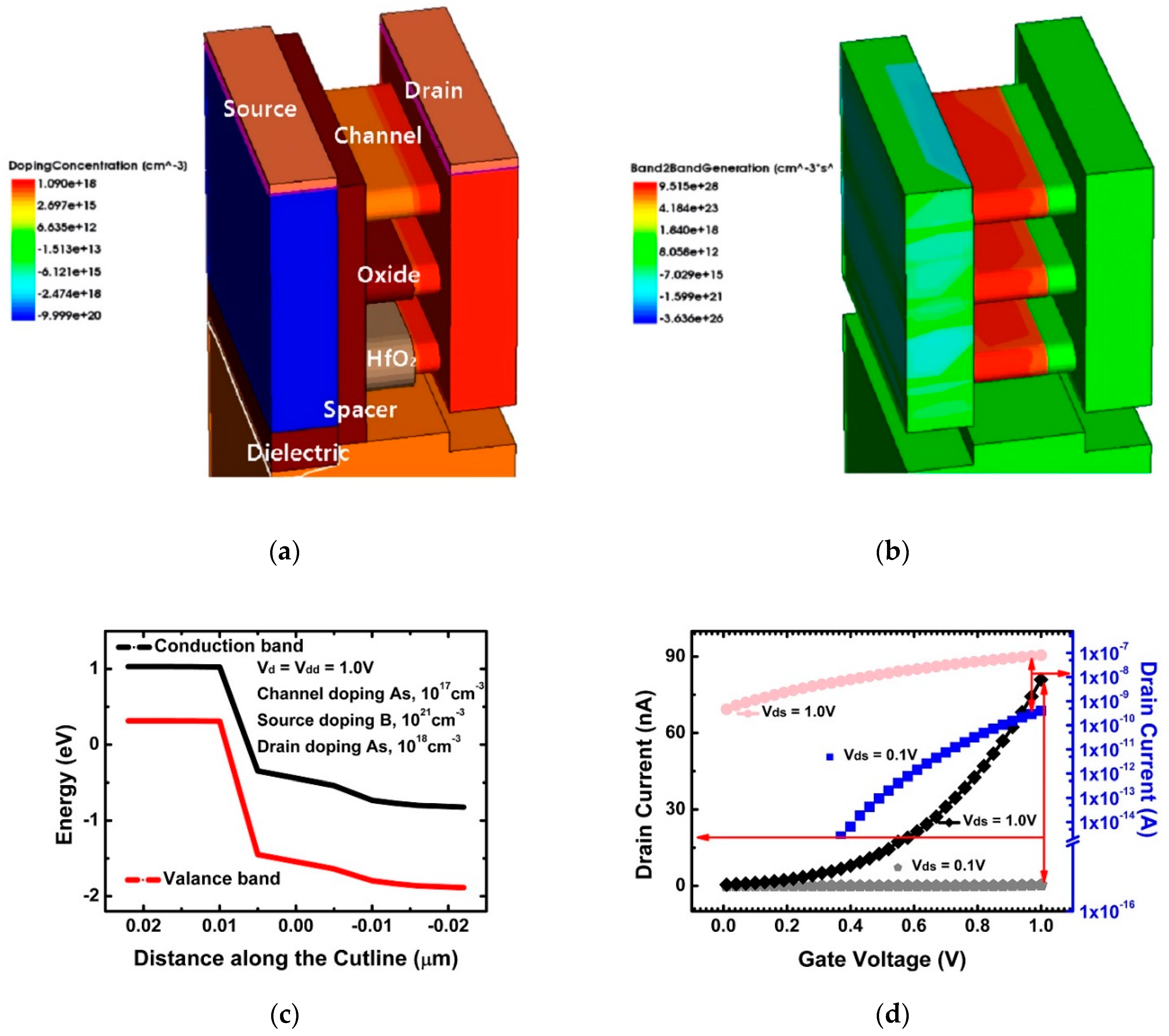

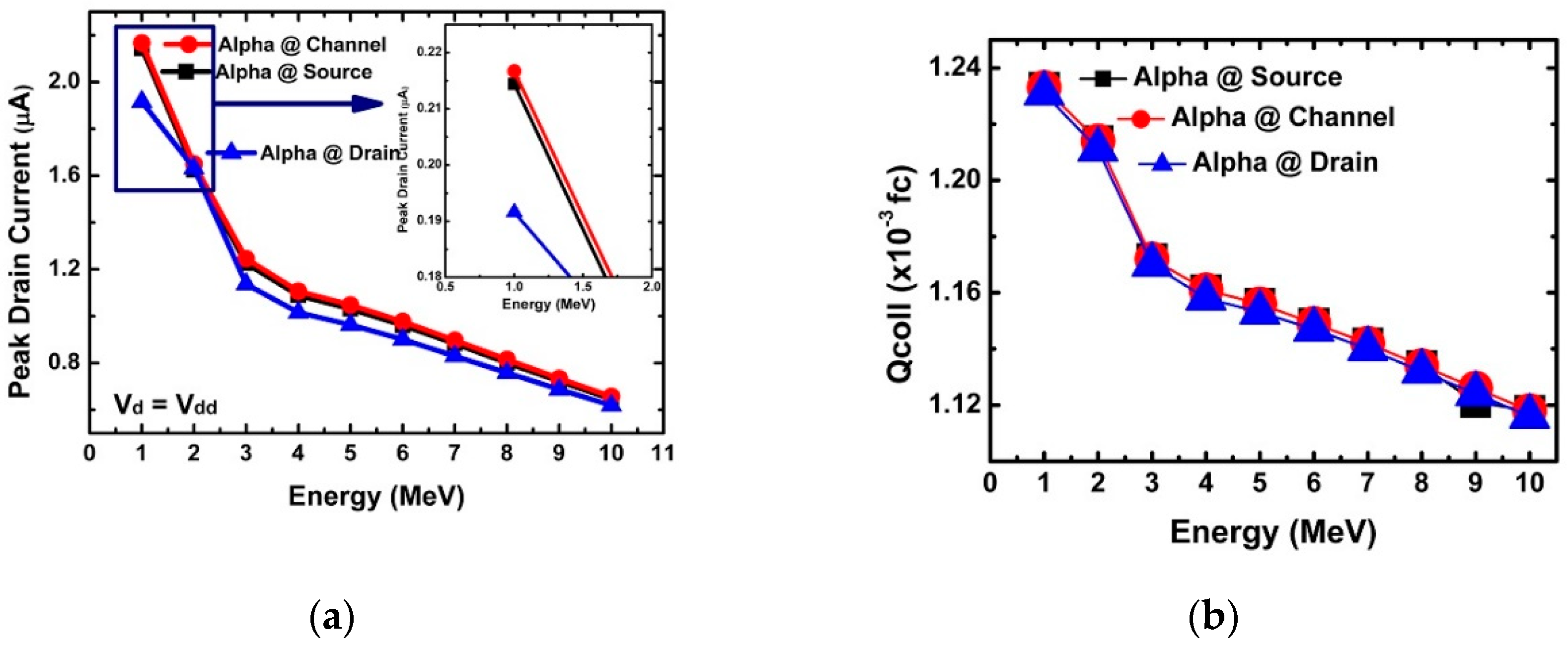
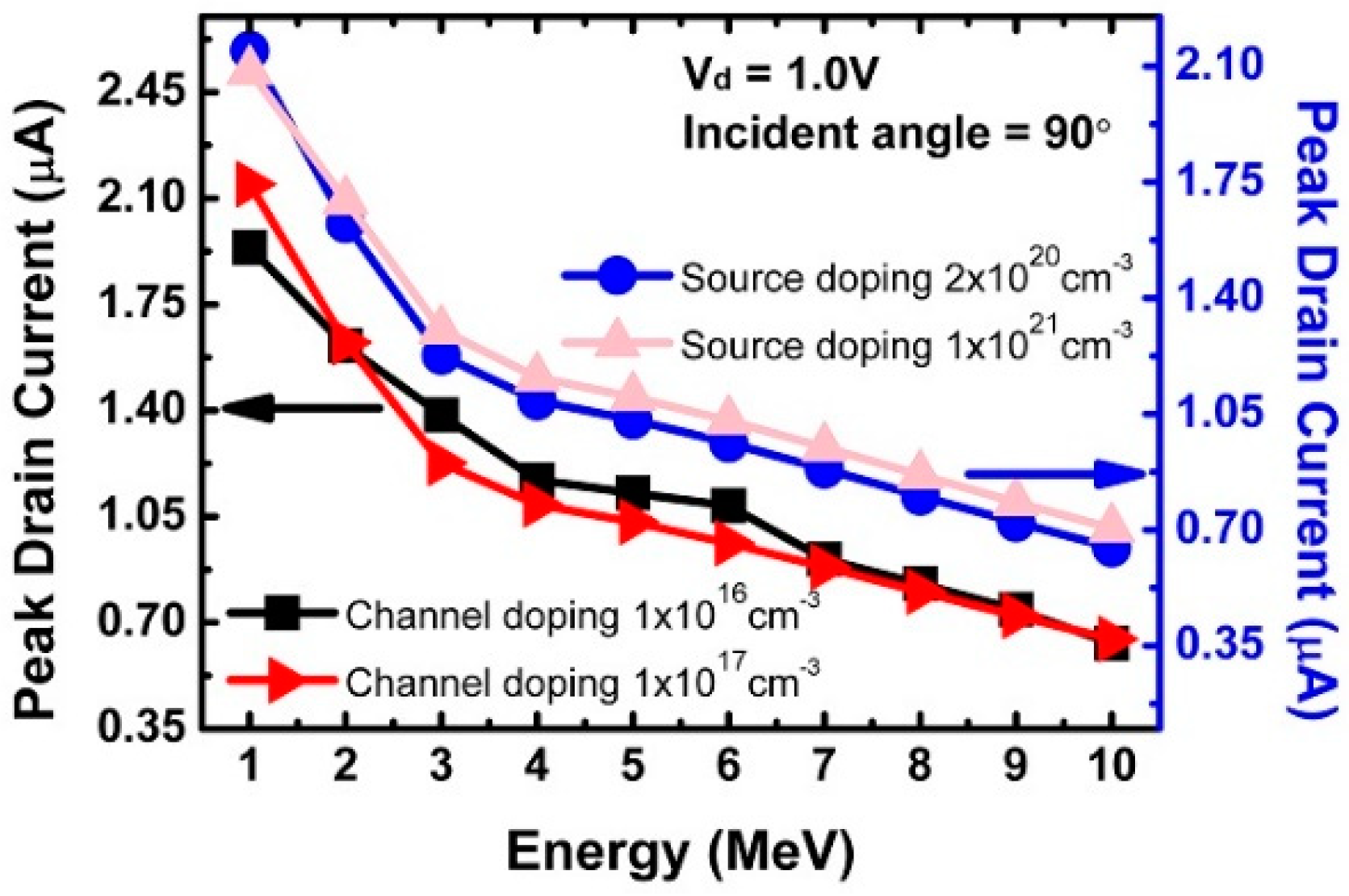
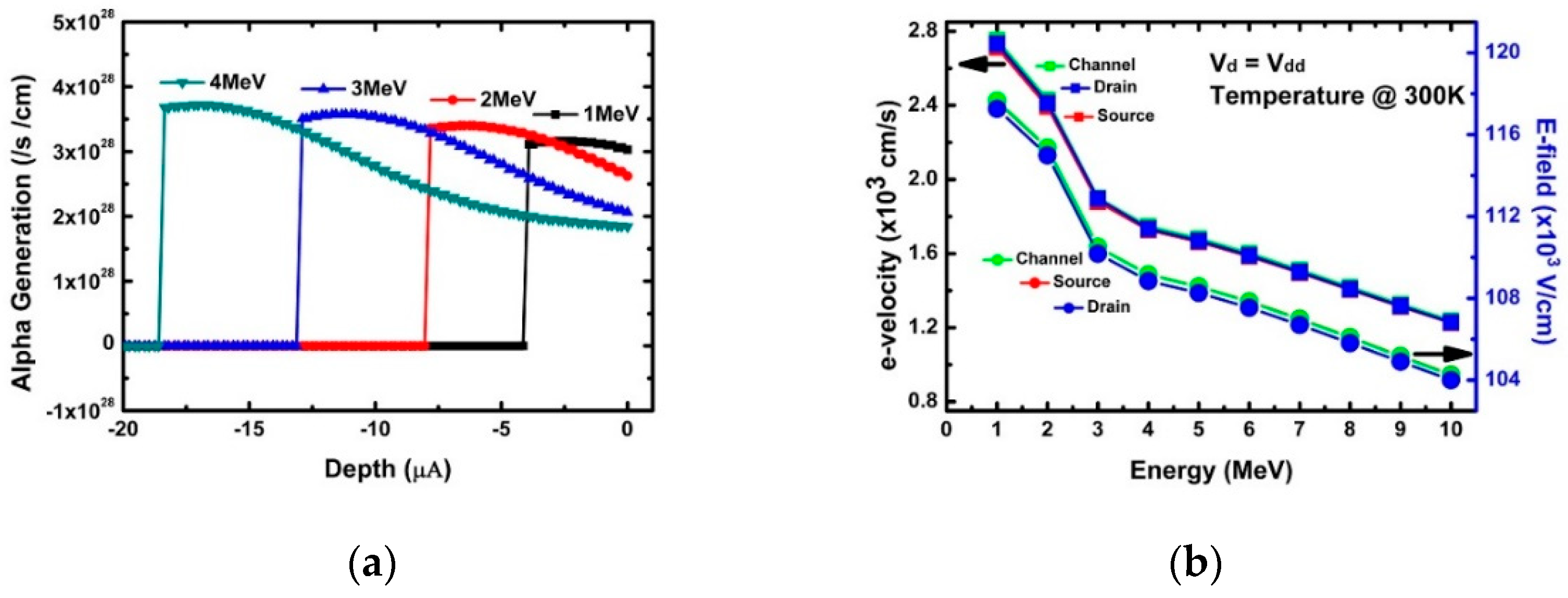
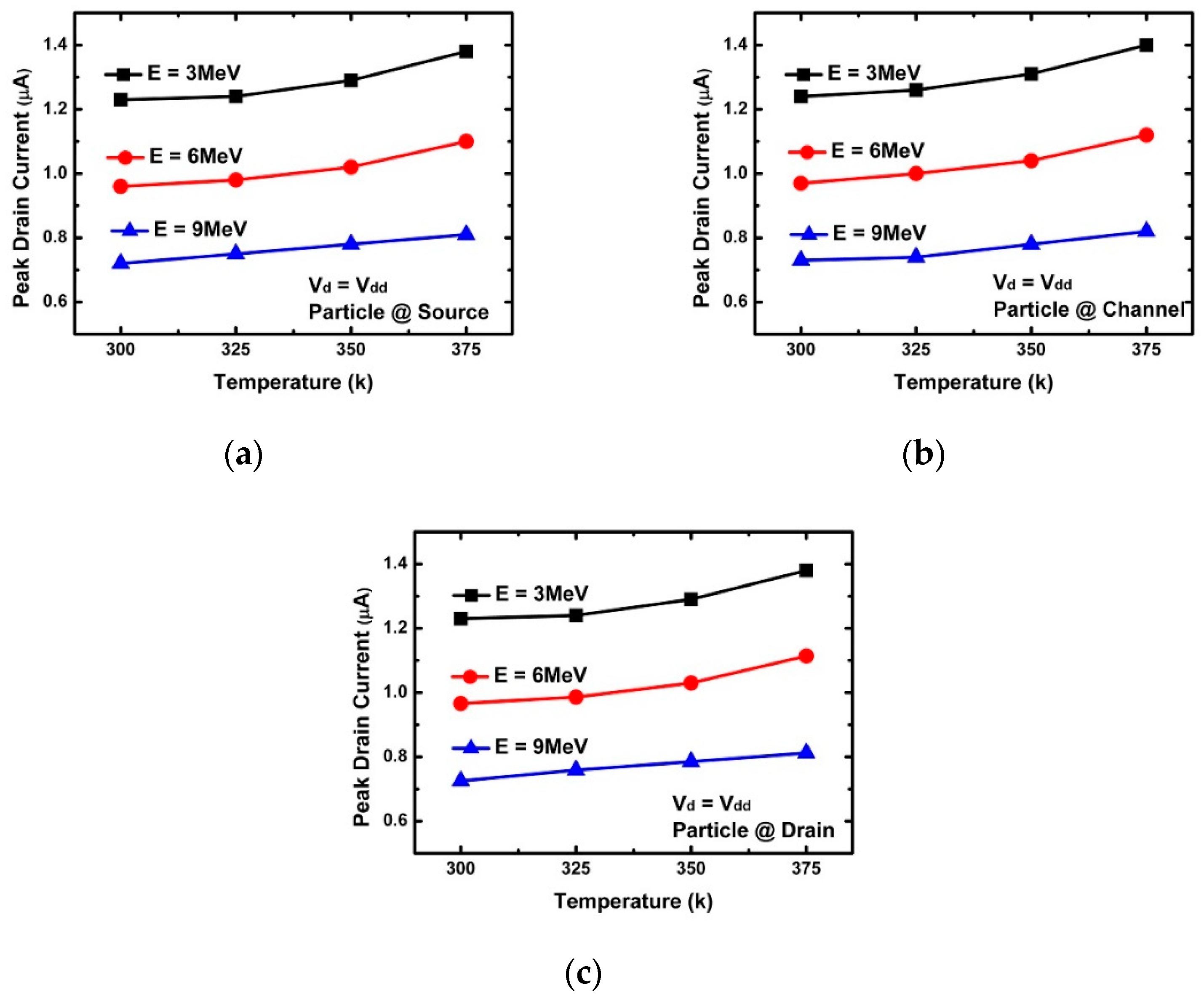
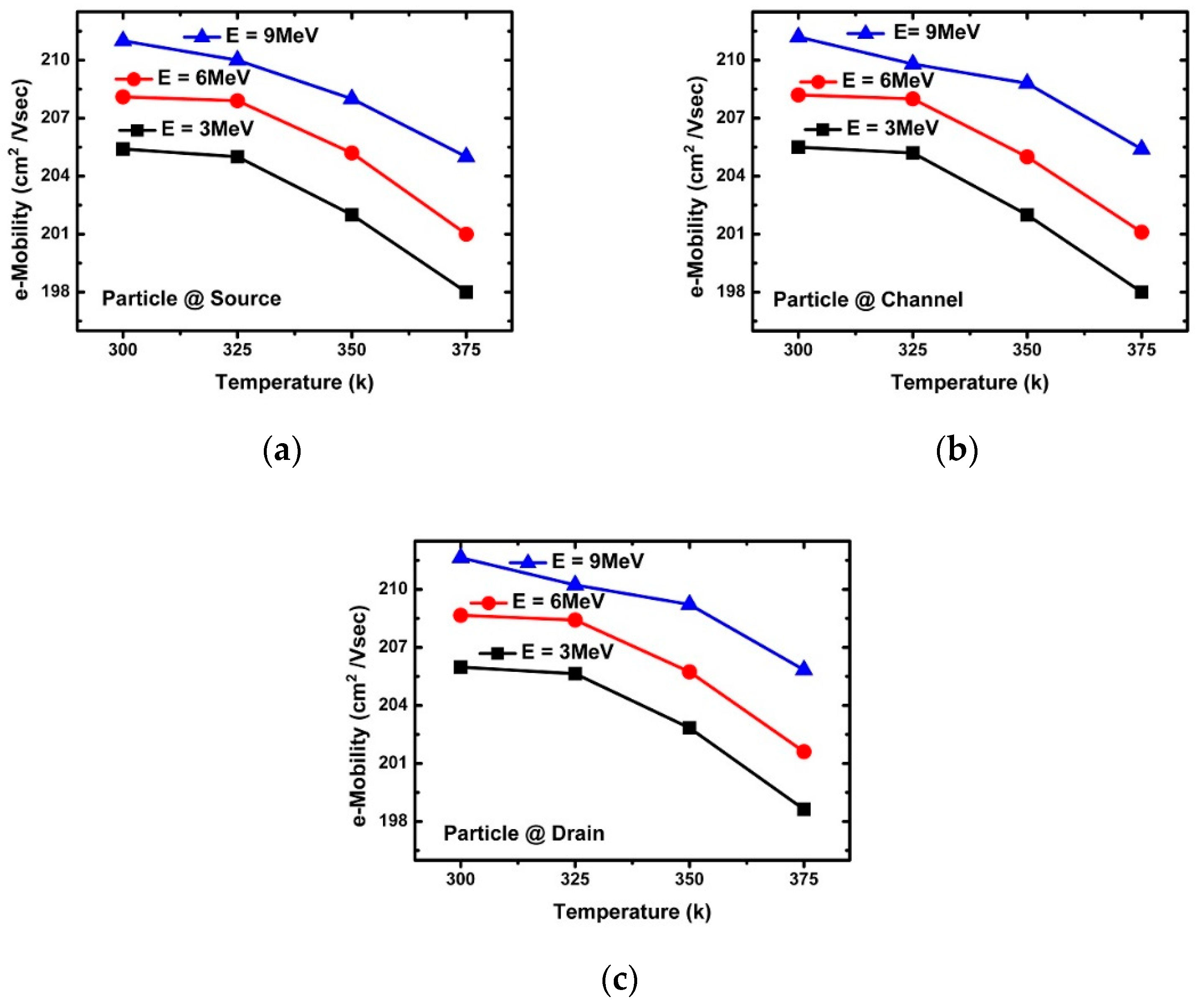

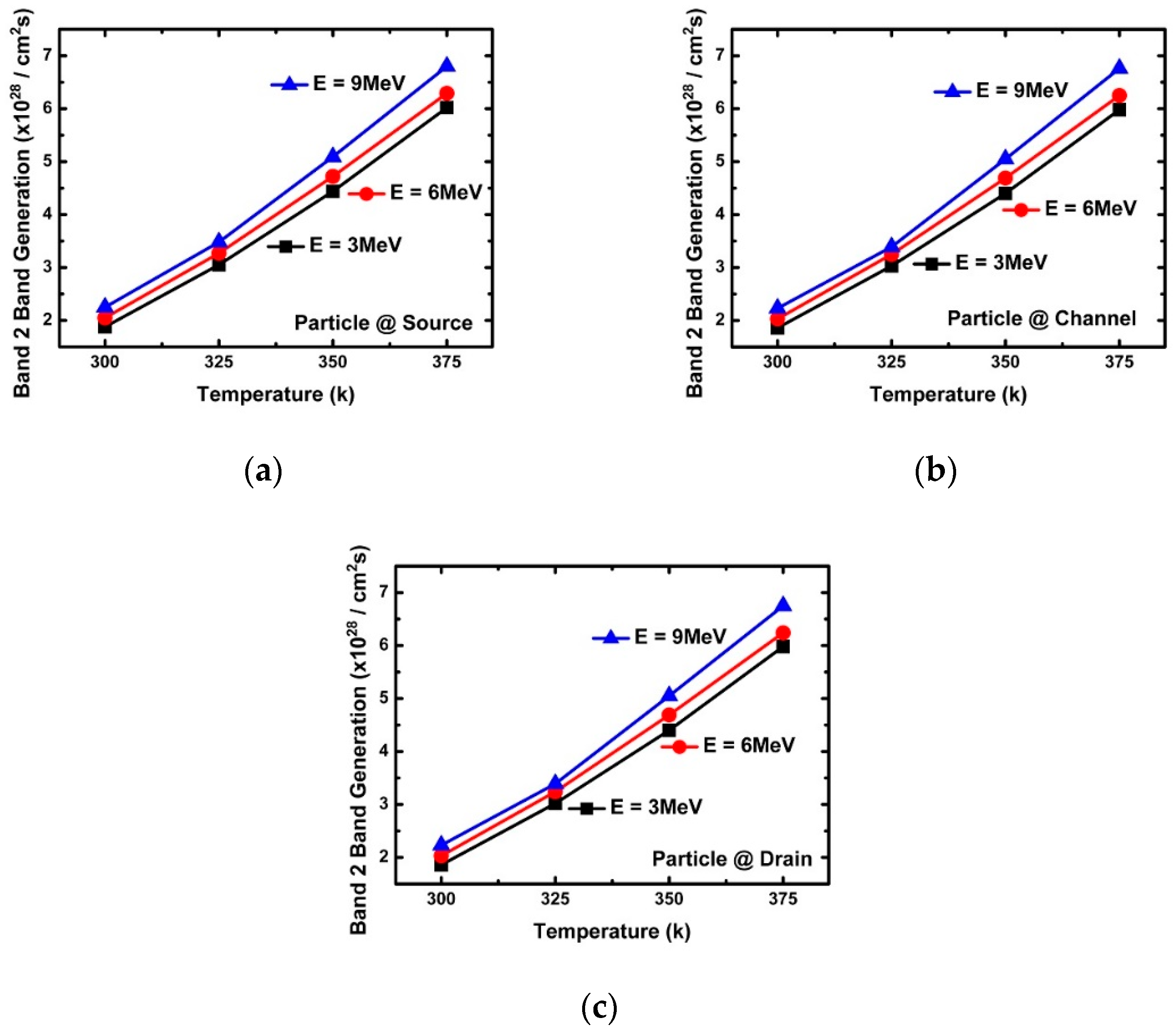
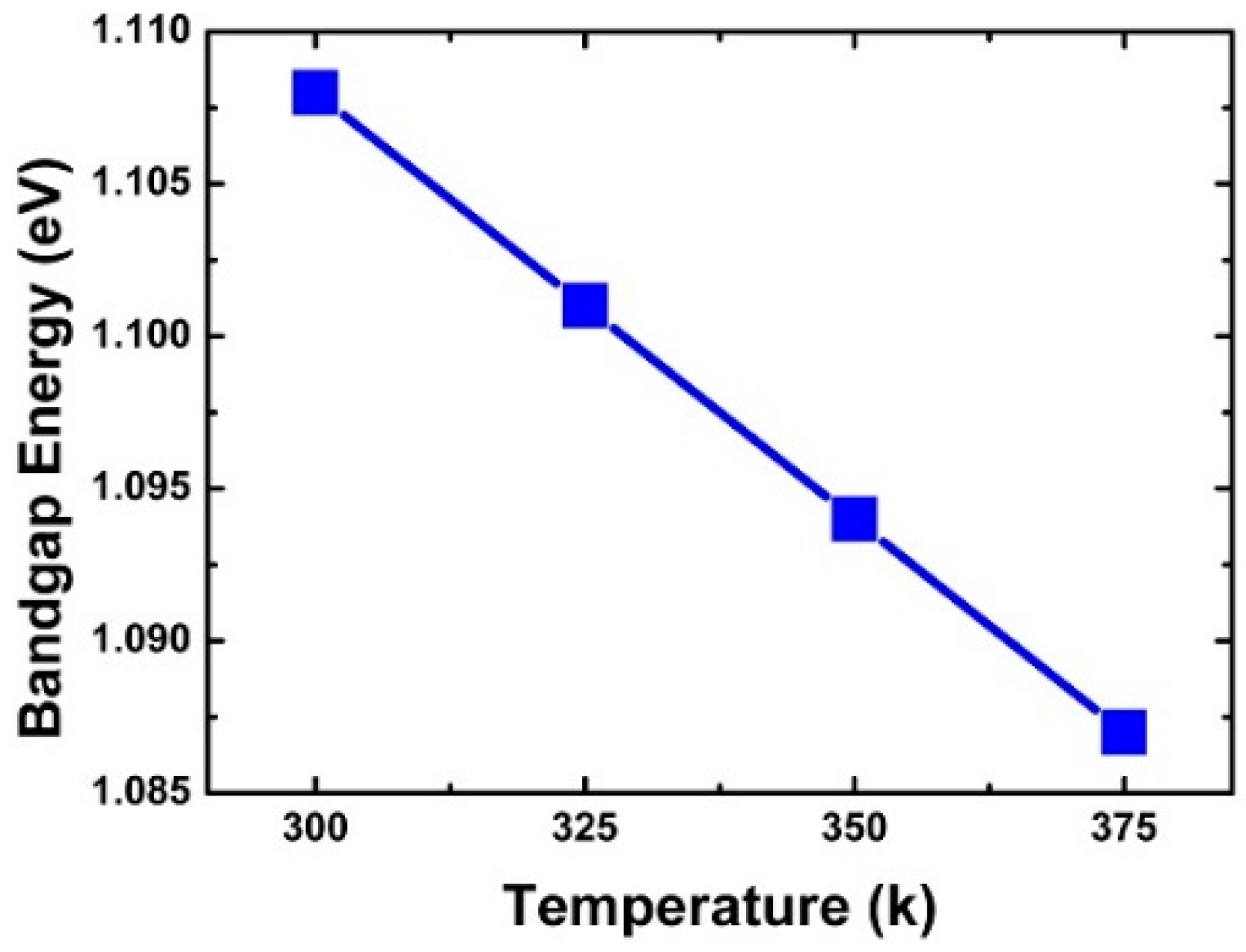
| Device Parameters | Value | Device Parameters | Value |
|---|---|---|---|
| Gate length, Lg (nm) | 10 | Ambient temperature (K) | 300–375 |
| Channel width, Tw (nm) | 16 | Alpha particle energy (MeV) | 1–10 |
| Channel thickness, Tch (nm) | 5 | Incident angle (°) | 30–90 |
| Contact gate pitch, CGP (nm) | 23.5 | Source doping (cm−3) | B, 1021 |
| Effective oxide thickness (nm) | 0.68 | Drain doping (cm−3) | As, 1018 |
| Contact resistance (Ω-cm−3) | 3 × 10−9 | Channel doping (cm−3) | As, 1017 |
| Gate voltage (Vg) (V) | 0–1.0 | Drain voltage (Vd) (V) | 0.1, 1.0 |
© 2019 by the authors. Licensee MDPI, Basel, Switzerland. This article is an open access article distributed under the terms and conditions of the Creative Commons Attribution (CC BY) license (http://creativecommons.org/licenses/by/4.0/).
Share and Cite
Hong, J.; Park, J.; Lee, J.; Ham, J.; Park, K.; Jeon, J. Alpha Particle Effect on Multi-Nanosheet Tunneling Field-Effect Transistor at 3-nm Technology Node. Micromachines 2019, 10, 847. https://doi.org/10.3390/mi10120847
Hong J, Park J, Lee J, Ham J, Park K, Jeon J. Alpha Particle Effect on Multi-Nanosheet Tunneling Field-Effect Transistor at 3-nm Technology Node. Micromachines. 2019; 10(12):847. https://doi.org/10.3390/mi10120847
Chicago/Turabian StyleHong, Jungmin, Jaewoong Park, Jeawon Lee, Jeonghun Ham, Kiron Park, and Jongwook Jeon. 2019. "Alpha Particle Effect on Multi-Nanosheet Tunneling Field-Effect Transistor at 3-nm Technology Node" Micromachines 10, no. 12: 847. https://doi.org/10.3390/mi10120847
APA StyleHong, J., Park, J., Lee, J., Ham, J., Park, K., & Jeon, J. (2019). Alpha Particle Effect on Multi-Nanosheet Tunneling Field-Effect Transistor at 3-nm Technology Node. Micromachines, 10(12), 847. https://doi.org/10.3390/mi10120847




